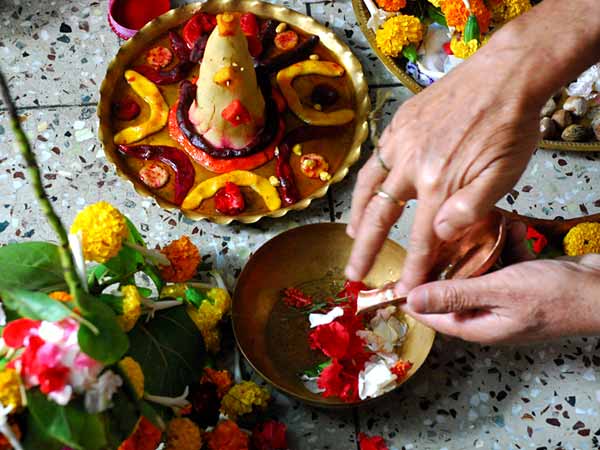Hindu wedding symbolizes traditional customs and
rituals. It signifies the strongest social bond between a man and a
woman. The sacred rituals build up the foundation of the marriage.
Hindu Marriage Rituals

|
According to Hindu Sastra there are four stages of life, of which Grahastha Ashram or married life signifies the second stage. It begins, when a man and a woman come together and marry. In India, marriage is treated as an institution, which teaches the actual values of life. Every stage in life has its own charm and a married life is no exception. In India, a marriage is usually arranged by the respective parents of the bride and the groom and follows various steps. Marriage among Hindus is not only considered a union of two souls, but of two families.
Hindu Marriage Rituals & Customs
A Hindu wedding not only involves the bride and groom but the entire community, friends, family and relatives as everybody participates in their coming together of the to-be couple. The first and the foremost step is the selection of the bride and the bridegroom. While in love marriages, a boy and a girl themselves select their life partner, it is crucial when it comes to arranged marriages. Talking about arranged marriages in the Hindu custom, the parents select the prospective bride/groom for their son/daughter.
After the selection procedure is over, the family members of both the girl and boy ask the priest to suggest an auspicious date for the engagement of the two also known as misri or ring ceremony. Since India boasts of diverse cultures and traditions, the engagement ceremony rituals differ from region to region and community to community. However, the basic of all the rituals, mentioned here, form an indispensable part of Hindu wedding. In the betrothal ceremony, the to-be bride and the groom exchange wedding rings among each other. Sweets and garlands are also exchanged among the couple.
After the festive spirit of engagement, the next important ritual is the mehndi party. It is believed that the color of mehndi signifies the essence of love in a marriage, so it is put on bride's hand to strengthen that bond of love. The bride's family and friends mainly celebrate this ceremony. The female friends and family members of the bride rejoice and celebrate this occasion, as henna gets painted on her hands and feet. Apart from the bride, the family members also get their hands painted with henna. Singing traditional songs and dancing to the beat of music forms a major part of this ritual.
Among the other important rituals is the Sangeet party, wherein all the family members and friends of the bride and groom celebrate, by singing and dancing the night away. Along with song and dance there are arrangements for food and drink. A large affair, Sangeet party is most popular among Punjabis, Marwaris and Gujaratis, although most of the regions today also practice this ritual. Ghari puja is also another important religious ceremony, which is performed on the eve of the wedding day at the groom and bride's place separately.
On the morning of the wedding day, Pithi or Haldi, the cleansing ceremony is practiced during which the bride and bridegroom are pasted with turmeric powder in their respective homes, as a part of their beautification process. Talking about the actual marriage ceremonies, the Hindu wedding mostly takes place in a mandap or a tent, which is beautifully decorated with flowers. The main Hindu wedding ceremony is a long and elaborate affair, which lasts for several hours and is attended by a large number of relatives, friends, acquaintances and so on.
One of the most significant rituals the bride and the groom perform is the Saptapadi or saat phere around a scared fire and light, which is symbolic to God. While the bride and the groom take the seven circles, the priest or purohit recites the mantras and speak of the real essence and significance of marriage. It is also during this time that the groom fills vermillion or sindoor in the center parting of the bride and puts mangalsutra around her neck. Both sindoor and mangalsutra have strong religious implications and are sacred symbols of a married woman. These were some of the rituals and customs, which were generally followed in all the Hindu marriages.



